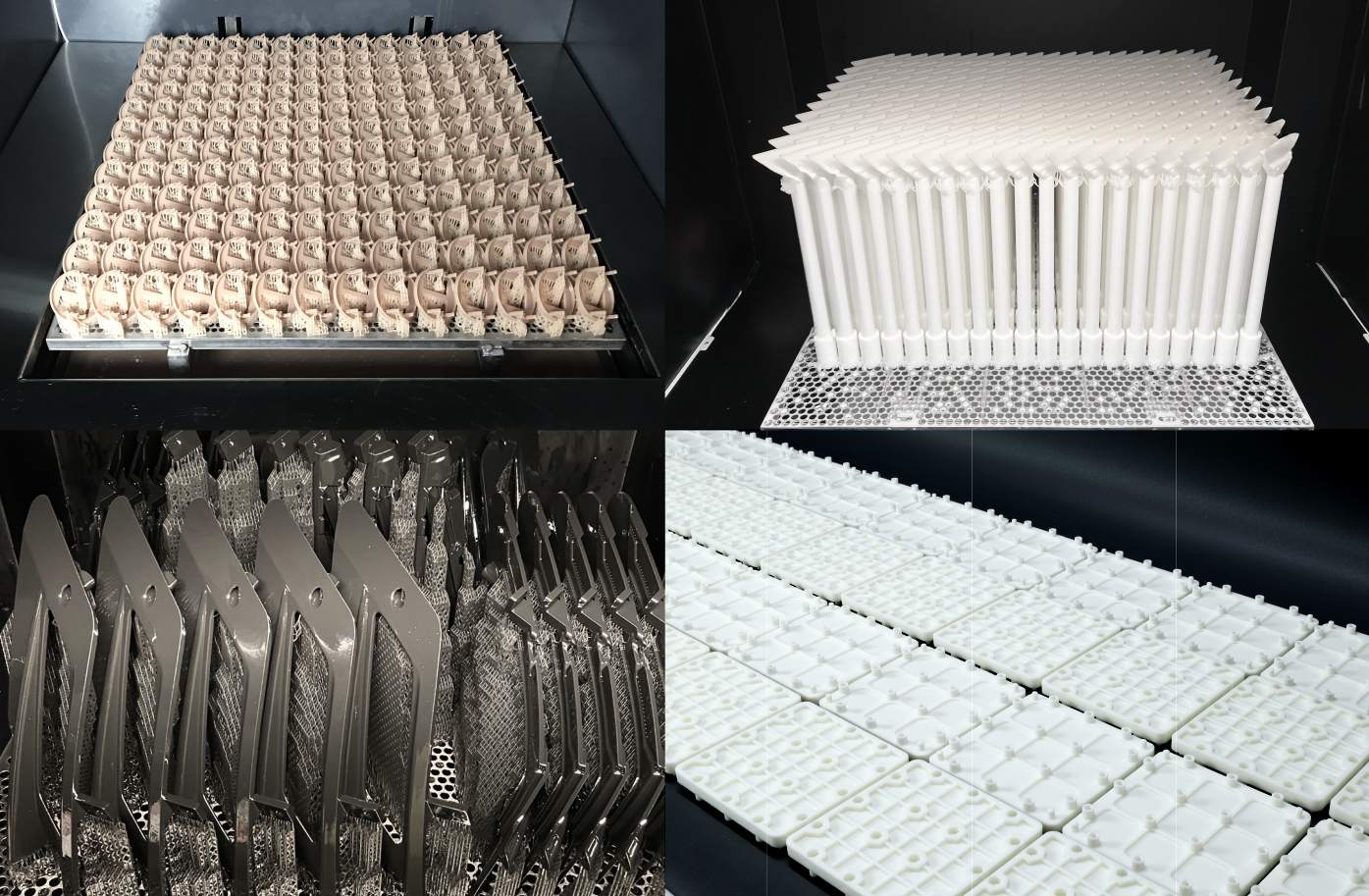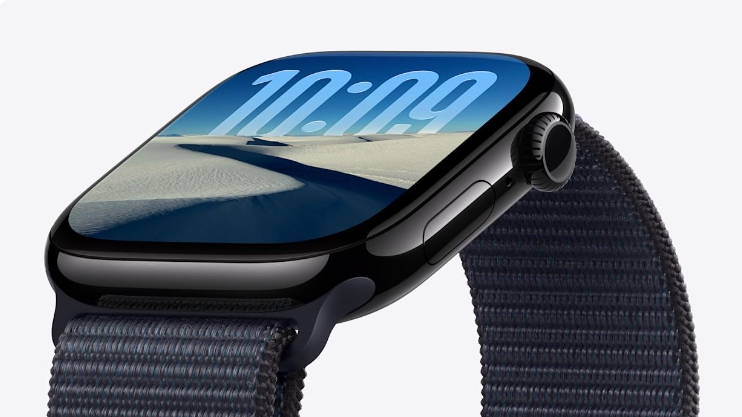
글로벌 기술 혁신을 선도하는 애플(Apple)은 2030년까지 전사적인 탄소중립을 달성하겠다는 야심 찬 목표를 세웠습니다. 이를 위해 애플은 재료, 전기, 운송이라는 3대 탄소 배출원을 줄이기 위한 혁신적인 제조 기술을 적극적으로 채택하고 있습니다. 그중 가장 흥미로운 발전은 바로 산업용 3D프린팅을 생산 공정에 본격적으로 통합한 것입니다.

최근 발표에 따르면, 역대 가장 얇은 두께(5.6mm)를 자랑하는 새로운 아이폰 에어(iPhone Air)의 티타늄 USB-C 포트는 3D프린팅으로 제작됩니다. 이 3D프린팅 설계는 포트를 더 얇고 강하게 만드는 동시에, 기존 단조 방식 대비 재료 사용량을 33%나 줄이는 획기적인 성과를 거두었습니다. 나아가 새로운 애플 워치 11(Apple Watch 11) 역시 3D프린팅으로 티타늄 케이스를 제작하였습니다.

애플의 이러한 행보는 산업용 3D프린팅이 더 이상 시제품 제작을 위한 보조 도구가 아님을 명확히 보여줍니다. 이제 이 기술은 자원 효율성을 극대화하고 탄소중립 목표를 달성하기 위한, 가장 까다로운 품질 기준을 가진 글로벌 기업들이 선택하는 핵심 양산 기술로 자리 잡았습니다.
자원 효율의 극대화: 필요한 만큼만 사용하는 산업용 3D프린팅

산업용 3D프린팅의 가장 근본적인 환경적 이점은 재료 사용의 효율성에 있습니다. 전통적인 절삭 가공은 큰 재료 덩어리를 깎아서 원하는 형태를 만들기 때문에, 많게는 90%에 달하는 재료가 폐기물로 버려집니다. 이는 막대한 자원 낭비일 뿐만 아니라, 원자재 채굴 및 가공 과정에서 발생하는 탄소 배출을 고려할 때 환경에 큰 부담을 줍니다.
3D프린팅이 제공하는 '설계의 자유(Design Freedom)'는 자원 효율성을 한 단계 더 끌어올립니다. 기존 방식으로는 제작이 불가능했던 복잡한 내부 격자 구조(Lattice Structure)나 위상 최적화(Topology Optimization) 설계를 통해, 제품의 강도는 유지하면서도 사용되는 재료의 양을 획기적으로 줄일 수 있습니다.
산업용 3D프린팅은 디지털 설계도에 따라 필요한 부분에만 재료를 한 층씩 쌓아 올리는 ‘적층’ 방식을 사용합니다. 이는 재료 낭비를 원천적으로 최소화하여, 탄소중립을 향한 첫걸음이 됩니다.
제품 수명 연장: 주문형 생산과 맞춤형 부품 생산

산업용 3D프린팅은 필요한 시점에 필요한 만큼만 제품을 생산하는 ‘주문형 생산(On-demand Manufacturing)’을 가능하게 합니다. 이는 대량생산 시스템에서 흔히 발생하는 과잉 생산과 재고 부담을 원천적으로 차단하여 자원 낭비를 막는 데 크게 기여합니다.
또한, 제품의 수명을 연장하여 지속 가능성을 높이는 데 결정적인 역할을 합니다. 과거에는 단종되었거나 구하기 어려운 부품 하나 때문에 제품 전체를 폐기해야 했습니다. 하지만 3D프린팅을 이용하면 디지털 설계 파일만 있다면 언제든지 맞춤형 부품을 쉽게 제작하여 수리하거나 재제조할 수 있습니다. 이는 소비자의 '수리할 권리'를 실현하는 강력한 도구이며, 제품의 조기 폐기를 막아 폐기물 발생을 줄입니다.
이러한 접근은 제조업체가 단순히 새 제품을 판매하는 것에서 벗어나, 수리·유지보수·업그레이드를 통해 장기적인 가치를 제공하는 '서비스형 제품(Product-as-a-Service)' 모델로 전환하는 데 기여하며, 이는 순환경제의 목표와 정확히 일치합니다
글룩의 키오스크 외장품 제조 사례를 통해 재고없는 제조사례를를 확인하세요!
재고 없는 키오스크 제조, SLA 3D프린팅으로 실현한 유연한 하드웨어 생산
재고 없는 키오스크 제조, SLA 3D프린팅으로 실현한 유연한 하드웨어 생산
금형 없이 실현한 주문형 생산 – 산업용 SLA 3D프린팅 기술로 바꾼 벤디트의 제조 혁신차세대 숙박 자동화 솔루션 기업, 하드웨어 생산도 디지털로 혁신하다디지털 전환(Digital Transformation)이 전
gluckblog.com
폐기물의 재탄생: 순환경제를 완성하는 3D프린팅 소재 혁신
산업용 3D프린팅은 다양한 소재를 활용할 수 있는 유연성을 바탕으로, 버려지는 폐기물을 가치 있는 자원으로 재탄생시키는 순환경제의 핵심 기술입니다. 과거 매립되거나 소각될 수밖에 없었던 폐플라스틱, 음식물 쓰레기, 산업 폐기물 등이 3D프린팅의 새로운 소재로 주목받고 있습니다.

구체적인 사례로, 유럽연합(EU)의 BARBARA 프로젝트는 석류, 레몬, 아몬드 껍질과 같은 음식물 쓰레기를 자동차 및 건설 산업에 사용될 수 있는 바이오 기반 필라멘트로 개발하는 연구를 진행했습니다. 2020년 도쿄 올림픽에서는 폐플라스틱을 재활용하여 3D 프린팅으로 제작한 시상대가 사용되었으며, 이탈리아의 한 디자인 회사는 폐플라스틱을 활용해 3D 프린팅으로 쓰레기통을 만들기도 했습니다.
이러한 사례들은 지역적으로 발생하는 폐기물을 현지에서 필요한 제품으로 즉시 전환하여 새로운 소규모 경제를 창출하고, 글로벌 공급망에 대한 의존도를 줄여 운송 과정에서 발생하는 탄소 배출까지 줄일 수 있는 가능성을 보여줍니다. 이는 탄소중립 사회로 나아가기 위한 중요한 전략입니다.
산업용 3D프린팅은 자원 효율성 극대화, 폐기물의 자원화, 제품 수명 연장, 공급망 최적화를 통해 탄소중립과 순환경제 실현에 기여하는 강력한 기술입니다. 애플과 같은 글로벌 기업의 선택은 이러한 흐름을 증명하며, 앞으로 더 많은 산업 분야에서 그 중요성이 커질 것입니다.
GLUCK은 대량생산이 가능한 산업용 3D프린팅 서비스 기업입니다.
작은 아이디어를 반복 가능한 생산성으로 전환해, 현실 가능한 제조 솔루션을 제공합니다.
지금 글룩에 문의해 보세요.
📩 제작 및 상담 문의: support@glucklab.com

Apple’s Choice of 3D Printing: Industrial 3D Printing Technology for Carbon Neutrality
Apple, a global leader in technological innovation, has set an ambitious goal to achieve company-wide carbon neutrality by 2030. To this end, Apple is actively adopting innovative manufacturing technologies aimed at reducing the three main sources of carbon emissions: materials, electricity, and transportation. Among the most notable advancements is the full-scale integration of industrial 3D printing into its production processes.

According to recent announcements, the titanium USB-C port of the new iPhone Air—the thinnest iPhone ever at just 5.6 mm—has been manufactured using 3D printing. This design not only makes the port thinner and stronger, but also reduces material usage by as much as 33% compared to conventional forging methods. Moreover, the new Apple Watch 11 also features a titanium case produced through 3D printing.

Apple’s move clearly demonstrates that industrial 3D printing is no longer just a tool for prototyping. Instead, it has become a core mass-production technology chosen by global companies with the most stringent quality standards, enabling maximum resource efficiency and advancing carbon neutrality goals.
Maximizing Resource Efficiency: Industrial 3D Printing Uses Only What’s Needed

The most fundamental environmental advantage of industrial 3D printing lies in its efficiency in material usage. Traditional subtractive machining involves carving out a desired shape from a large block of raw material, often wasting up to 90% of the material. This results in enormous resource waste and significant environmental burdens due to the carbon emissions generated in mining and processing raw materials.
In contrast, industrial 3D printing employs an additive process, layering material precisely where it is needed according to digital blueprints. This fundamentally minimizes material waste, serving as the first step toward carbon neutrality.
Additionally, the “design freedom” offered by 3D printing further enhances resource efficiency. Through complex lattice structures and topology optimization—designs impossible to manufacture with traditional methods—products can be made lighter and stronger while using significantly less material.
Extending Product Lifespan: On-Demand Manufacturing and Custom Parts

Industrial 3D printing enables “on-demand manufacturing,” producing only what is needed, when it is needed. This eliminates overproduction and inventory burdens common in mass production systems, greatly reducing resource waste.
It also plays a decisive role in extending product lifespans and improving sustainability. In the past, entire products often had to be discarded due to a single discontinued or hard-to-find part. With 3D printing, however, as long as a digital design file exists, custom parts can be easily reproduced at any time for repairs or remanufacturing. This empowers consumers’ “Right to Repair” and prevents premature disposal, thereby reducing waste.
Such an approach allows manufacturers to move beyond simply selling new products, transitioning toward a “Product-as-a-Service” model that emphasizes repair, maintenance, and upgrades—aligning perfectly with the goals of a circular economy.
👉 See how Gluck applied this with kiosk exterior parts:
Inventory-free manufacturing with SLA 3D printing for flexible hardware production
Waste Reborn: Material Innovation Driving the Circular Economy

Industrial 3D printing, thanks to its versatility with materials, is a key technology for turning discarded waste into valuable resources—completing the cycle of the circular economy.
For instance, the EU’s BARBARA Project has developed bio-based filaments for the automotive and construction industries using food waste such as pomegranate, lemon, and almond shells. At the 2020 Tokyo Olympics, podiums made from recycled plastic via 3D printing were used, while an Italian design company created 3D-printed trash bins using discarded plastics.
These cases demonstrate how locally generated waste can be instantly transformed into useful products in the same region, fostering small-scale economies while reducing dependency on global supply chains. This, in turn, lowers carbon emissions from transportation—an essential strategy for a carbon-neutral society.
Industrial 3D printing contributes to carbon neutrality and the realization of a circular economy through maximized resource efficiency, material recycling, product lifespan extension, and optimized supply chains. Apple’s adoption of this technology underscores its growing importance, and its role is expected to expand across industries worldwide.
GLUCK is an industrial 3D printing service provider capable of large-scale production.
We transform small ideas into repeatable productivity, offering practical manufacturing solutions.
📩 Contact us for production and consultation: support@glucklab.com
#GLUCK #글룩 #3D프린팅 #산업용3D프린팅 #SLA3D프린팅 #대량생산 #DfAM #3D설계 #3D프린팅산업 #3D프린터 #3D모델링 #3D프린팅가격 #3D프린팅업체 #금형제작 #금형 #사출 #몰드제작 #3D프린팅견적 #3D출력 #MassProduction #3DPrinting #LargescaleProduction #AdditiveManufacturing #SLAtechnology #ManufacturingInnovation #DigitalTransformation #SmartManufacturing #탄소중립 #지속가능성 #순환경제 #ESG #애플 #CarbonNeutral #Sustainability #CircularEconomy #Apple #GreenTechnology
'인사이트 (Insights)' 카테고리의 다른 글
| 폴란드 항공 항공기 부품, 산업용 3D프린팅 통합설계(DFAM)를 통해 재탄생하다 (0) | 2025.10.13 |
|---|---|
| 개인 맞춤형 미래 모빌리티, 3D프린팅으로 제작된 Ather 전기 스쿠터 시트 (0) | 2025.10.10 |
| 로봇 R&D 속도를 바꾸는 산업용 3D프린팅 (0) | 2025.10.01 |
| 3D프린팅 매스 커스터마이징, 로봇 제조를 바꾸다! (0) | 2025.09.30 |
| 포드 머스탱 GTD의 주행 성능을 끌어올린 산업용 3D프린팅 (0) | 2025.09.26 |
